Aqualateral and Isle Utilities partner to help scale innovative water technologies
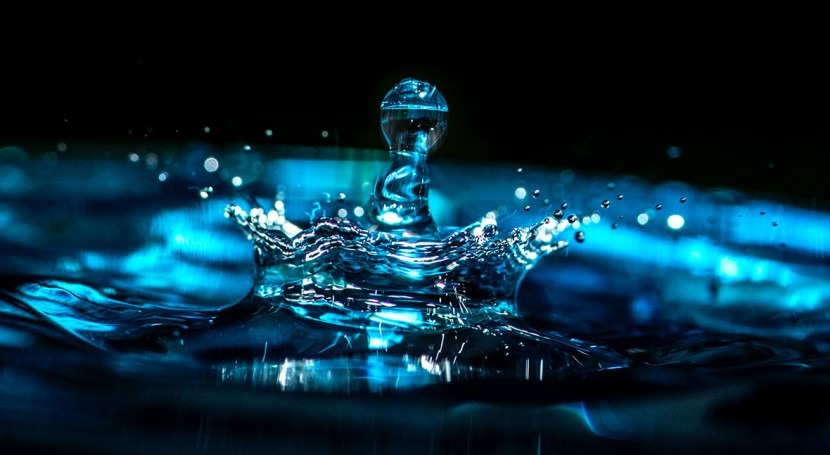


Germicidal glowsticks: Side-emitting optical fibers inhibit Pseudomonas aeruginosa and Escherichia coli on surfaces https://www.sciencedirect.com/science/article/abs/pii/S0043135420307284?via%3Dihub
Inhibition of biofouling on reverse osmosis membrane surfaces by germicidal ultraviolet light side-emitting optical fibers https://www.sciencedirect.com/science/article/pii/S0043135422010405?via%3Dihub
Nanoparticle and Transparent Polymer Coatings Enable UV-C Side-Emission Optical Fibers for Inactivation of Escherichia coli in Water https://pubs.acs.org/doi/10.1021/acs.est.9b01958
Short-Wave Ultraviolet-Light-Based Disinfection of Surface Environment Using Light-Emitting Diodes: A New Approach to Prevent Health-Care-Associated Infections https://www.ncbi.nlm.nih.gov/pmc/articles/PMC9959382/
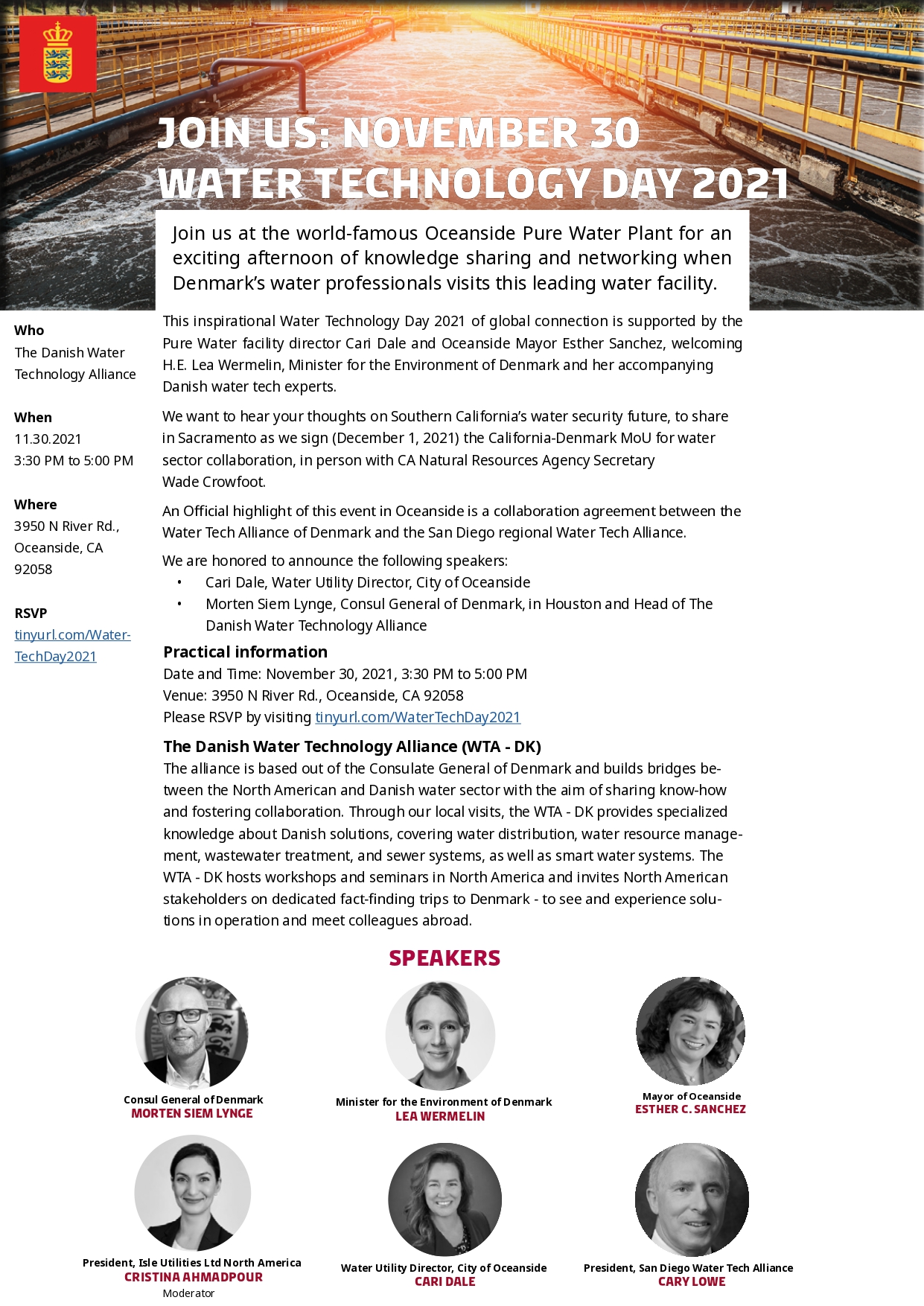

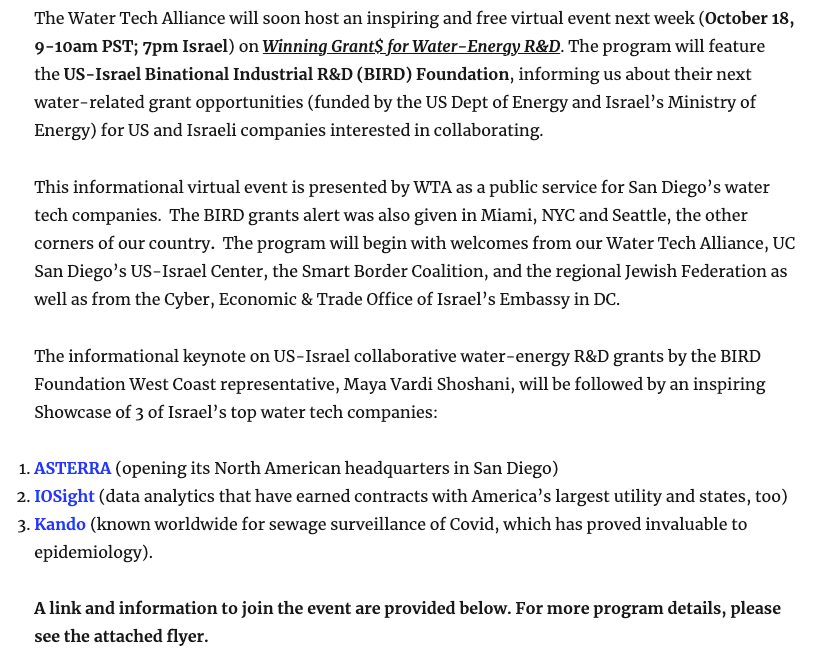
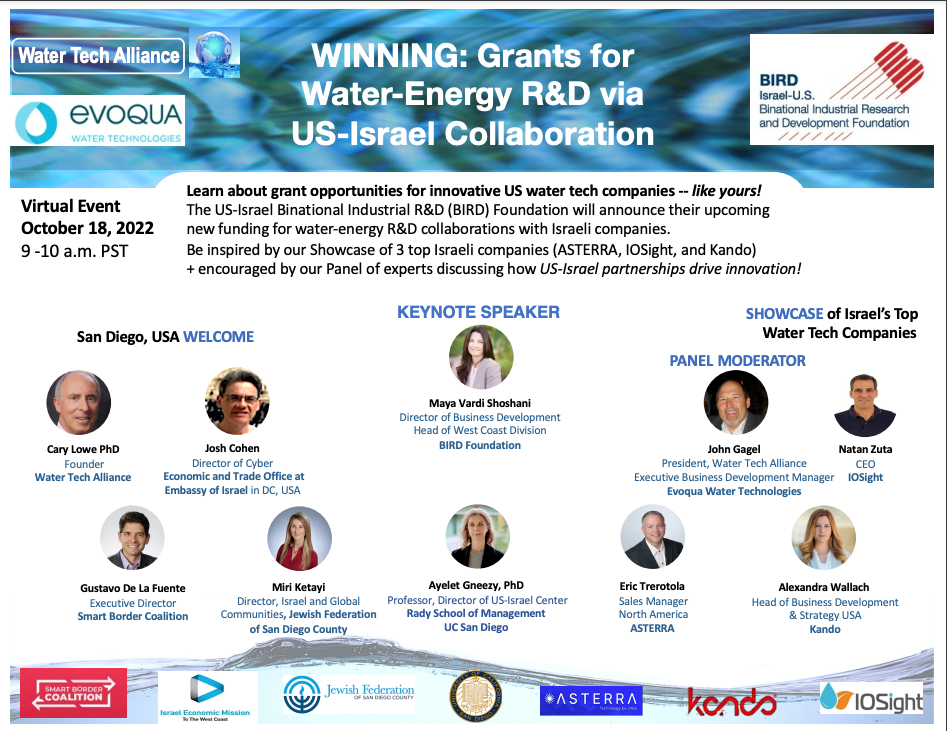
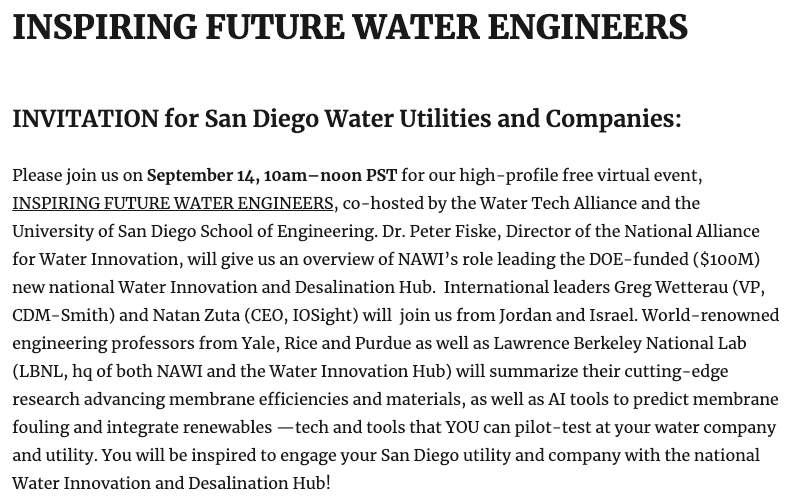
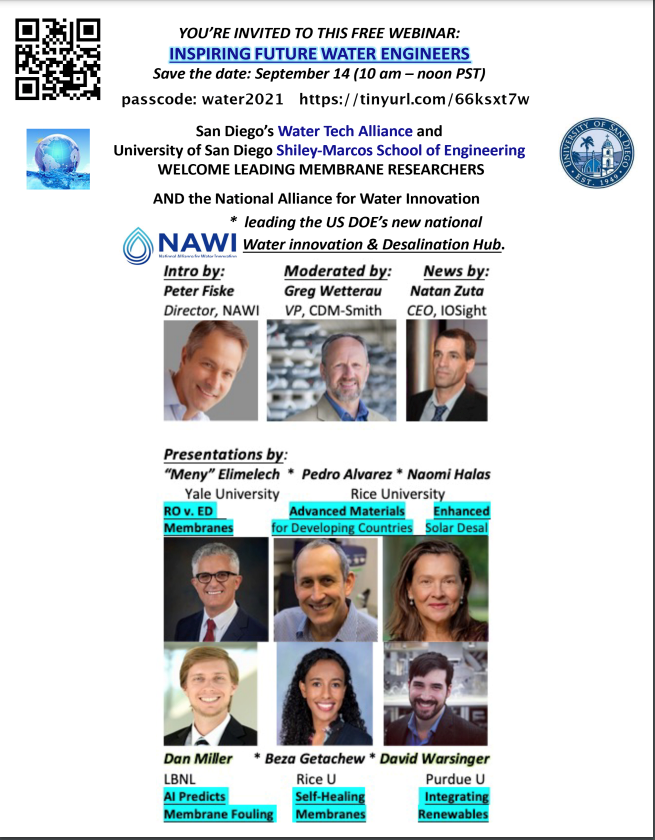
Dear Colleagues,
The Water Tech Alliance will host an inspiring and free virtual event (October 18, 9-10am) on Winning Grant$ for Water-Energy R&D. The program will feature the US-Israel Binational Industrial R&D (BIRD) Foundation, informing us about their next water-related grant opportunities (funded by the US Dept of Energy and Israel’s Ministry of Energy) for US and Israeli companies interested in collaborating.
This informational virtual event is presented by WTA as a public service for San Diego’s water tech companies. The BIRD grants alert was also given in Miami, NYC and Seattle, the other corners of our country. The program will begin with welcomes from our Water Tech Alliance, UC San Diego’s US-Israel Center, the Smart Border Coalition, and the regional Jewish Federation as well as from the Cyber, Economic & Trade Office of Israel’s Embassy in DC.
The informational keynote on US-Israel collaborative water-energy R&D grants by the BIRD Foundation West Coast representative, Maya Vardi Shoshani, will be followed by an inspiring Showcase of 3 of Israel’s top water tech companies:
ASTERRA (opening its North American headquarters in San Diego)
A link and information to join the event are provided to our registrants. We look forward to seeing you. This will be my last occasion representing the San Diego regional Water Tech Alliance, where I have been President since WTA’s founding in 2016, so it is particularly meaningful for me to encourage you to consider San Diego-global collaboration and innovation financing as a benefit to our future water security and economy. My successor, ,John Gagel, will lead the organization going forward.


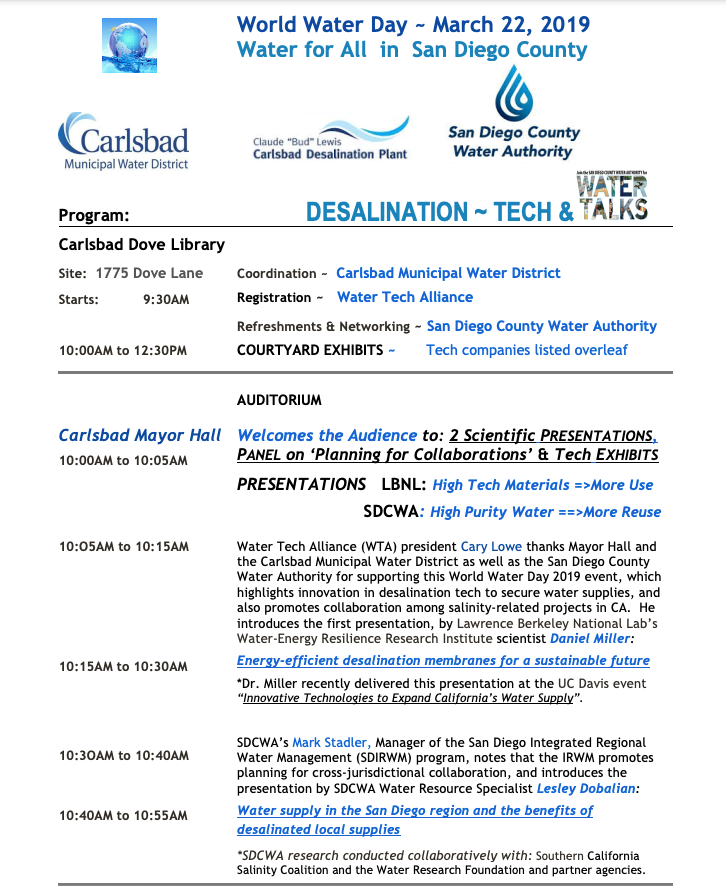
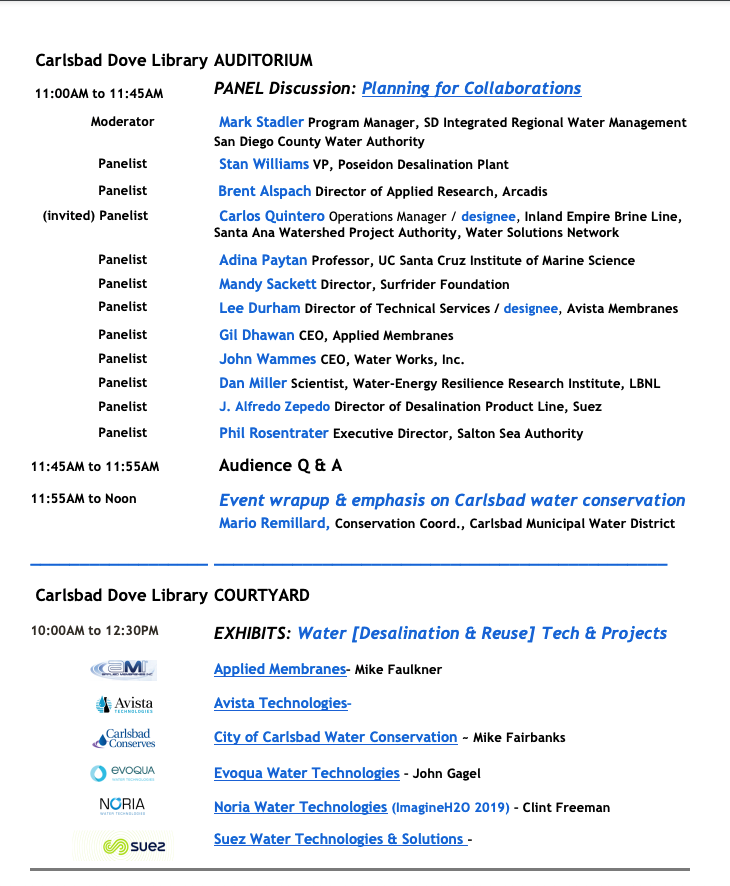


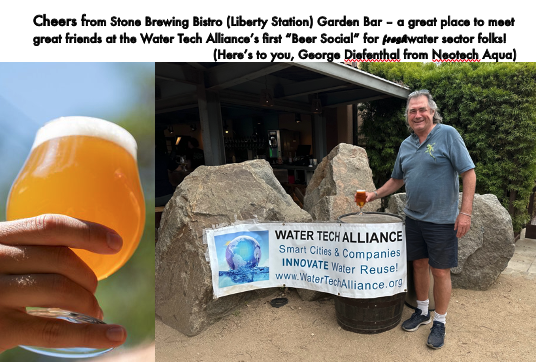

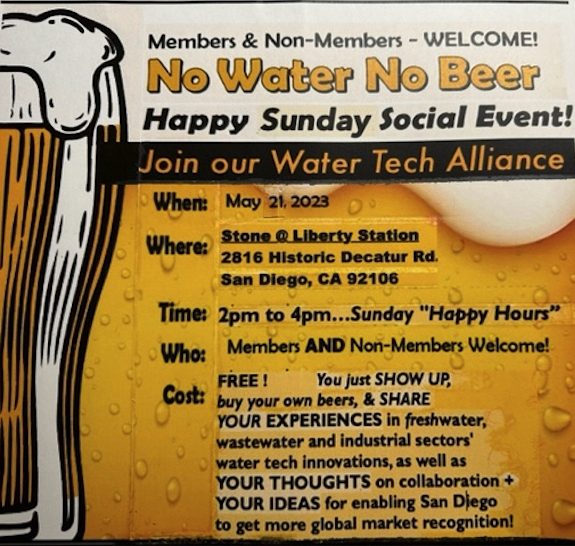
Please click on pop-ups (below) for 2022 Water Tech Solutions, Collaborations, and Recognition.
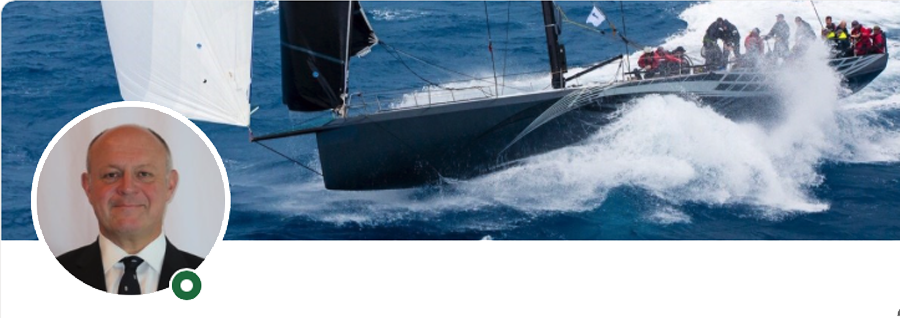
Dr. McClean recently (October 6, 2022) gave a keynote outlining
Developments in Advanced Filtration tech trends for the future, at the San Diego-hosted 13th World Filtration Conference
of international experts in water, wastewater and energy fields.”


World class Water UV systems from Evoqua Water Technologies. This is a de-ozonation application. Look at that tight footprint!
#water #technology #innovation #sustainability
Dr. Jon McClean is a dynamic and inspiring business leader serving as the Vice President, Technology & Innovation, for Evoqua Water Technologies (NYSE: AQUA). Headquartered in Pittsburgh PA, Evoqua is one of the world’s largest clean water tech companies, providing water and wastewater treatment solutions to a large variety of Fortune 500 companies, 7,800 wastewater sites throughout the country, and 1,800 water treatment sites throughout the world, via its manufacturing facilities and service offices across nine countries in more than 150 locations (including San Diego CA). Dr. McClean recently (October 2022) gave a keynote outlining related water tech trends for the future, at the San Diego-hosted international Filtration & Separation Conference of experts in water, wastewater and energy fields. His own expertise in ultra-violet (UV) disinfection tech enables his close attention to Evoqua’s new facility in the UK, manufacturing Evoqua’s ATG® UV product line of environmentally friendly, chemical-free UV disinfection systems for a wide range of applications (*including Adenovirus disinfection, TOC / urea reduction in UPW water AOP systems, and enhanced NDMA removal). The UK facility will also manufacture and distribute Evoqua’s Wallace & Tiernan brand of products for gas feed, chemical dosing and residual monitoring technologies that are the benchmarks for safe and reliable drinking water purification.
Dr. McClean oversees an even wider range of Evoqua products “Transforming Water…Enriching Lives”, including the compact low-pressure pretreatment and ultra-filtration Memcor® membrane systems used in many desalination projects (such in Singapore, where Evoqua is also opening a new global manufacturing facility for Evoqua’s Ionpure® Continuous Electrodeionization and other innovative products to support demand for ultrapure water (required in cellular and pharmaceutical manufacturing) in APAC and Indian markets. As the US Infrastructure Improvement Act aims to meet America’s needs of the future, Evoqua has recently completed acquisition of Epicor Inc. (supplier of ultra-pure water for power plants) and Ultrapure (TX) as well as the Smith Engineering (TX & NM) group specializing in water and wastewater public works; and environmental engineering fields of chemistry, microbiology, regulatory compliance, and equipment applications and controls. #EvoquaProud Dr. McClean exercises his PhD in Organizational Behavior (and MBA) in product marketing while deeply engaged with his colleagues in sustainability and engineering R&D at its new Sustainability & Innovation Hub (including digital innovation) in Lawrenceville PA, to accelerate identifying and remediating PFAS and other harmful contaminants in our communities. Dr. McClean’s willingness to share his expertise (in water and water quality, wastewater treatment –especially UV disinfection— and product development, process engineering, strategic planning, manufacturing, marketing, international sales, management, and even renewable –wind turbine— energy) with our Water Tech Alliance members, is a great honor and generous boon to us all
.
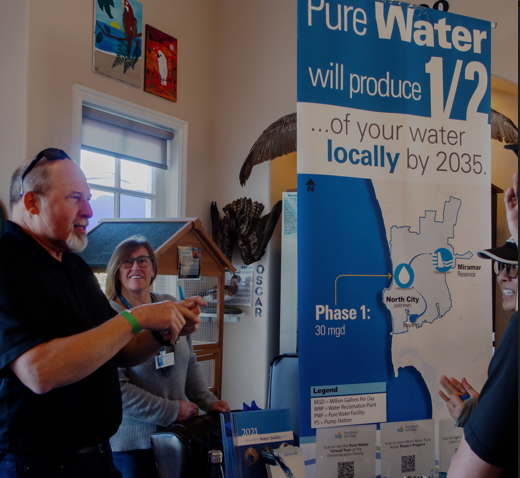
WTA’s new President John Gagel (Evoqua, now Xylem) speaks about UV disinfection.
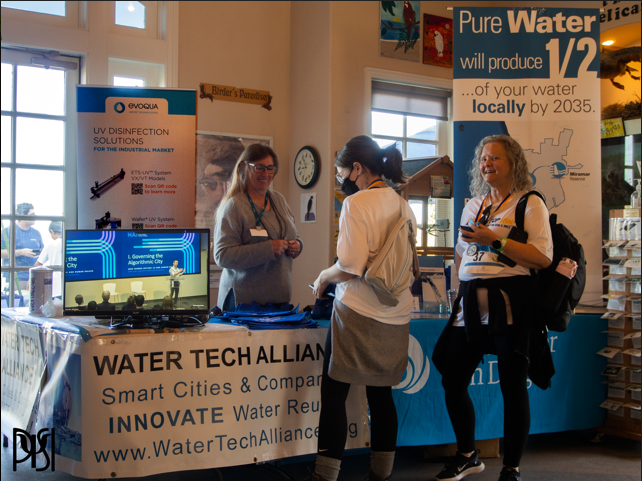


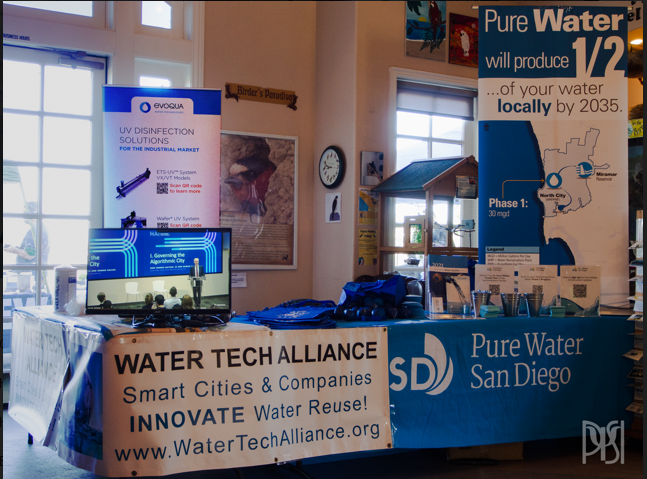
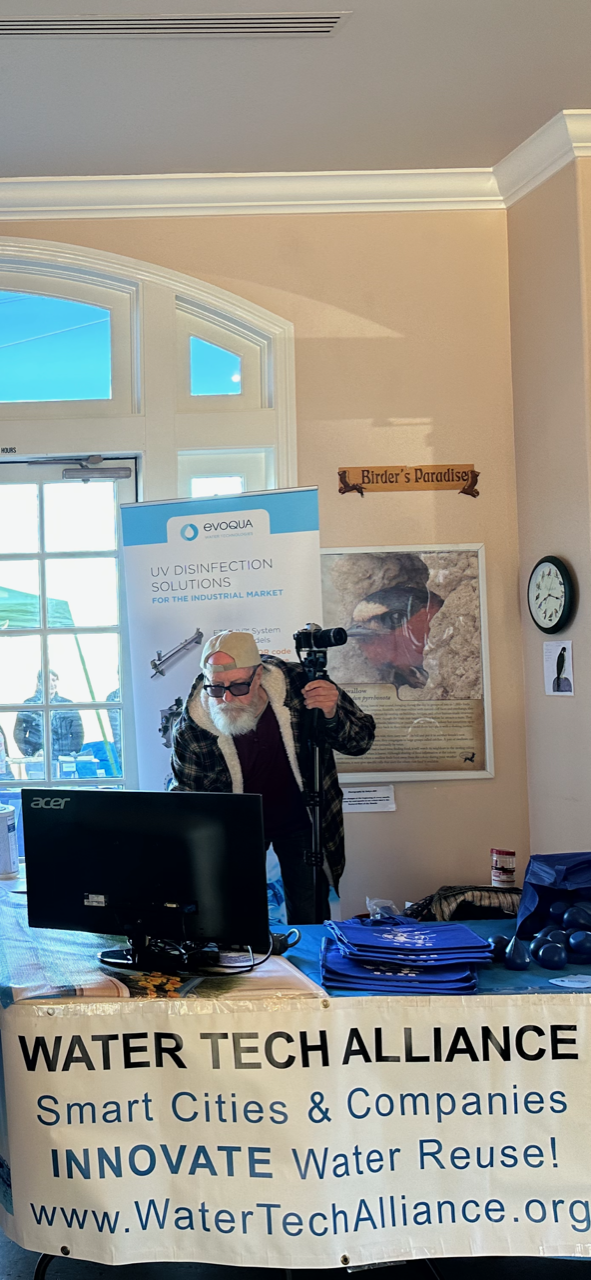

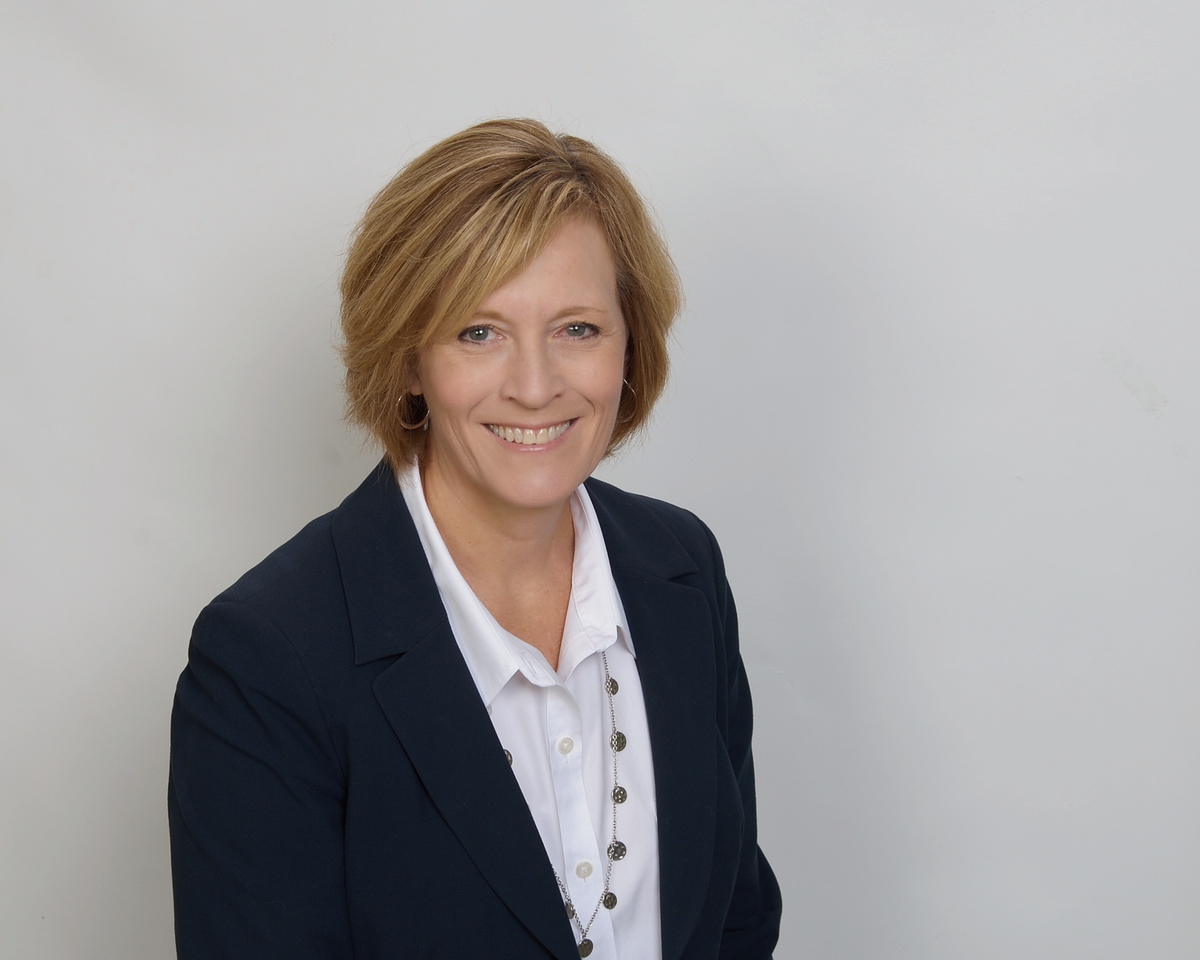
Tama Snow, P.E.,is a Vice-President and Regional Business Leader for Stantec, a global engineering, architecture and consulting firm.;she is responsible for growing and managing Stantec’s water practice in California and Hawaii. For over 30 years, she has been planning and executing projects that improve water resources management capabilities for public, private, and regulatory clients. She loves helping clients develop strategic and sustainable solutions to their challenges. Snow is an active member of the American Water Works Association and WateReuse Association, participating in industry engagement, including mentoring and community outreach, as well as colleagial collaboration. Tama is a graduate of the University of California at Riverside, University California at Irvine, and has a Master’s degree in Engineering from CalPoly Pomona.
Since 2015, Carlsbad’s Desalination Plant (the largest in N. America) uses RO of seawater supported by electronic sensors, data analytics, and AI controls, to create 50M gal/day of potable water for San Diego County.
Beautiful San Diego County –the USA’s fifth-most populous county in the USA—has 3.3M residents, and grows by 0.6% per year.
The thriving City of San Diego —the USA’s 8th largest city— is home to 1.4M people.
With our sister city Tijuana across the border in Mexico in this “economic megaregion” (the world’s 7th largest cross-border conurbation), 5M people and businesses face freshwater insecurity —unless more clean water can be created.
The Mayor of Carlsbad hosted WTA in 2019 to showcase the Poseidon (“Bud” Lewis) Plant.
WTA was founded in 2015, to showcase water cleantech that makes non/potable reuse and desalination possible.
WTA was founded in 2015, to showcase water cleantech that makes non/potable reuse and desalination possible.
Pure Water Oceanside (2021-now) produces 3M gal/day of drinking water from wastewater, using reverse osmosis (RO) membranes and ultra-violet (UV) oxidative disinfection.
Event Registration here: https://www.watercitizen.org/wtastormwater/
Students are again invited to our inspiring and free virtual events: https://www.watertechalliance.org/wp-content/uploads/2022/01/January-25-event-flyer-v8.pdf
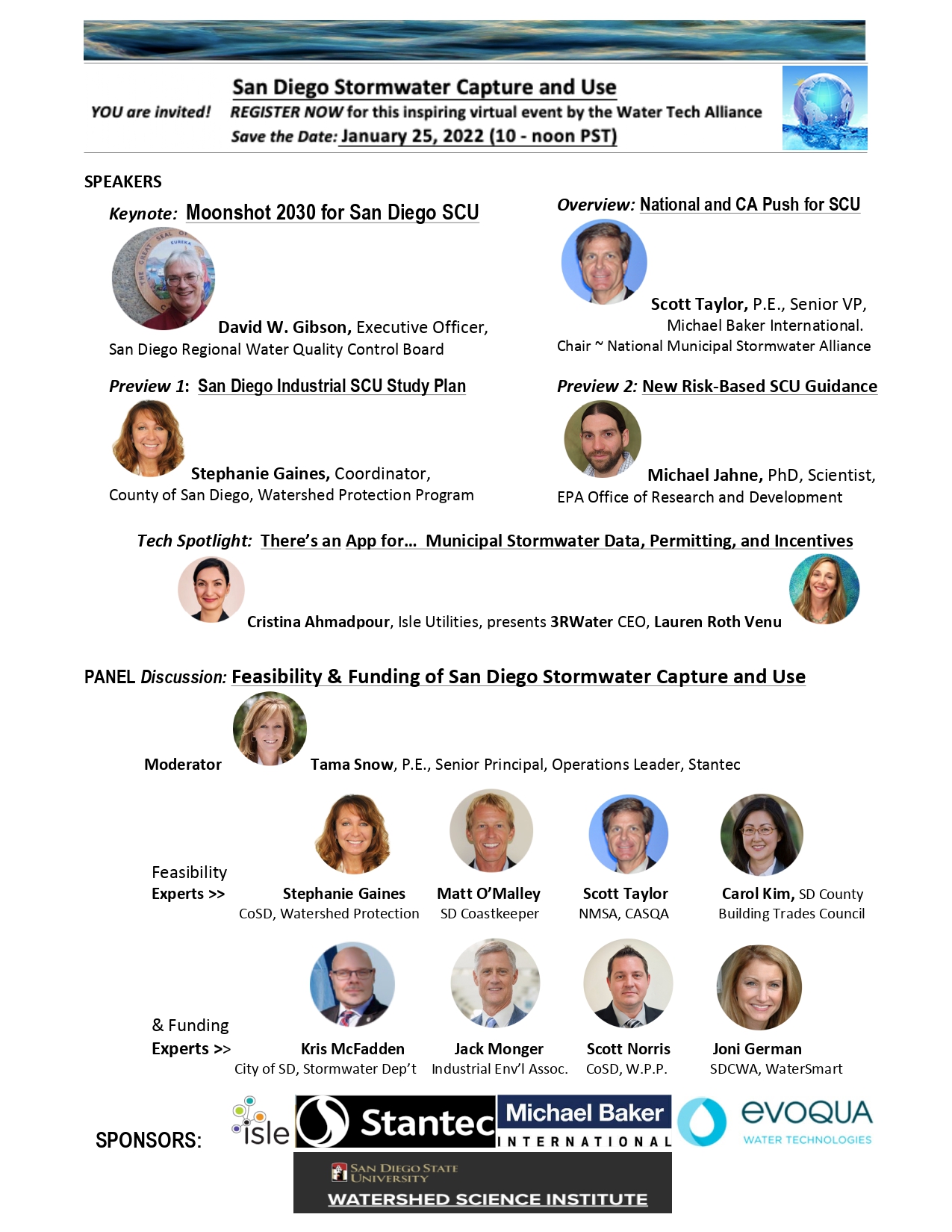


Executive Business Development Manager
Xylem (formerly Evoqua)
In the late 1950s, San Diego began recycling water to fill East County recreational lakes. In the 1990s, water utilities added 200 miles of purple pipe to send treated wastewater to irrigate public parks, campuses, golf greens, and fields. The San Diego Padres’ Petco Park keeps the outfield green with recycled water; and cuts costs of water, energy + operations by 25% with Qualcomm’s Intelligent Solutions for “Smart Cities, Smart Water”, we learned when Qualcomm hosted our Water Tech Alliance.
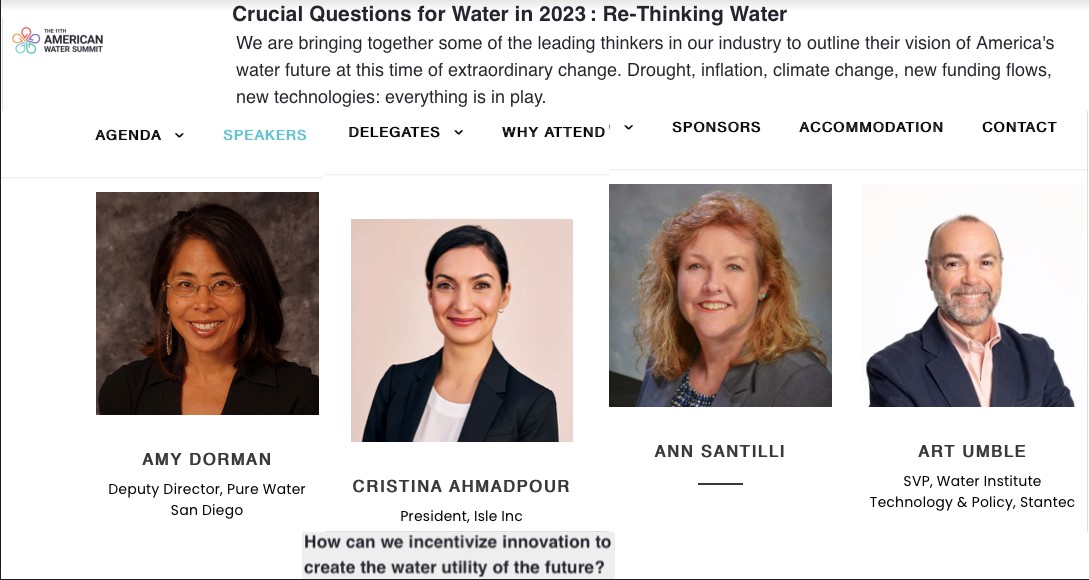
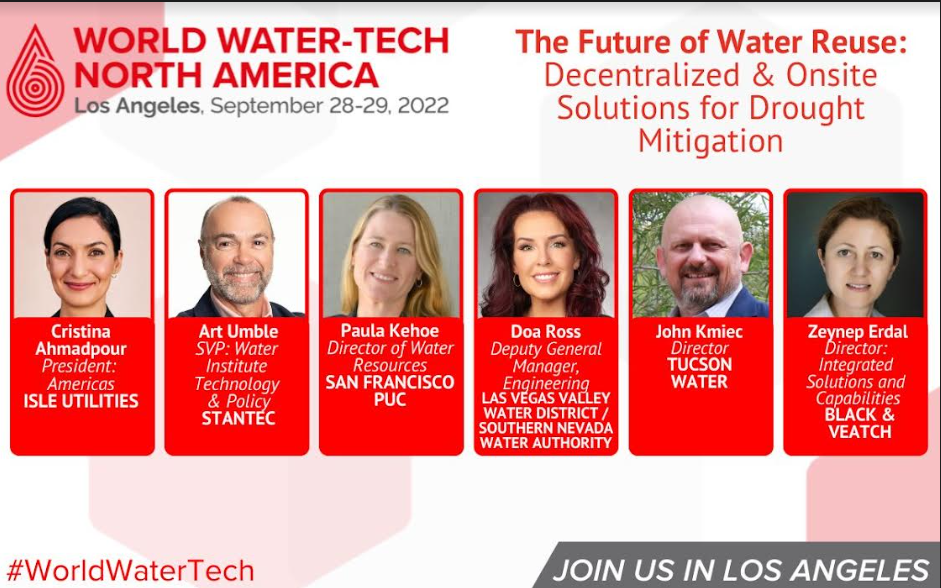
Cristina Ahmadpour is facilitating conversations on the future of water reuse with Doa Ross, P.E. John Kmiec, Paula Kehoe, Art Umble, and Zeynep Erdal, enabling intelligent debate and discussion of #decentralized solutions, #scalability, #incentives, and unique perspectives of what the water sector needs from the market to advance #reuse in a meaningful way.
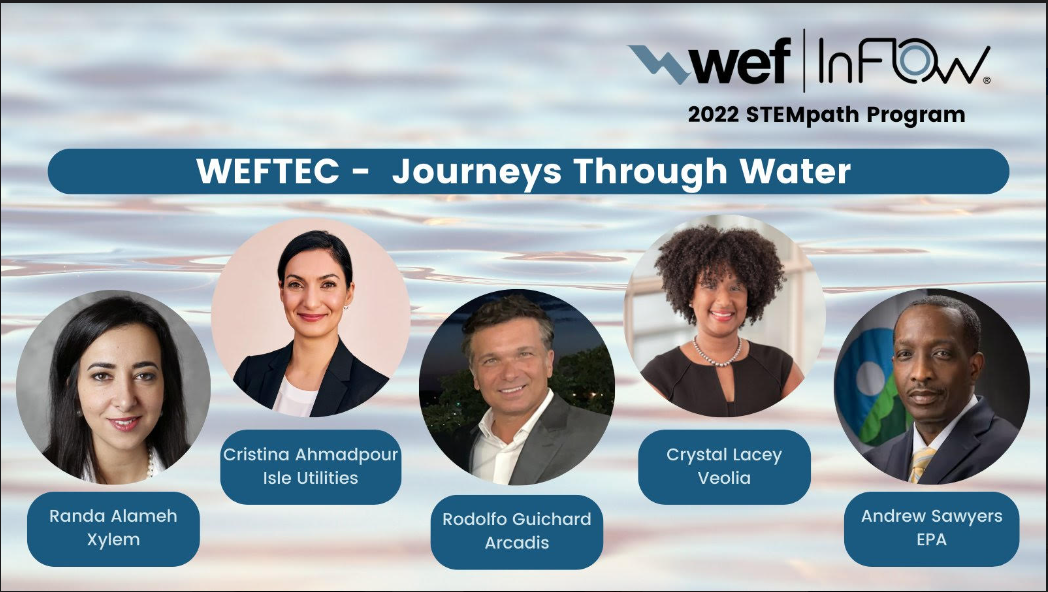
During and after WWII, San Diego developed military instrumentation and dashboards for aerospace and naval sectors. San Diego’s instrumentation expertise serves as a foundation for the “smart” tech and digital tools that optimize today’s water and wastewater systems.
Beginning in 1947, water was imported for the growing region and its agriculture. Over the next three decades, academia (UCSD and Salk in the ‘50s and ‘60s) grew a biotech sector in the 1970s, which contracted San Diego to ensure water security. In the 1980s, San Diego built its first wastewater treatment plant. Waste/water plant operators documented water quality data by hand for 50 years, until the digital revolution changed everything.
By 2000, the digital revolution of wireless connectivity had arrived. Local Fortune 500 company Qualcomm had sold 1M mobile phones. Its Code Division Multiple Access (CDMA) innovation grew wireless (WiFi) radio network areas (cells) and broadband connections to the worldwide web of interconnected devices —the internet— and grew our $245B economy. As cell phones became “smart phones” with an integrated computer, software, and web access, San Diego City and County water utilities also became “smart water” utilities. Network-connected cellular devices easily gather useful data, such as water flow and quality (the focus of Xylem‘s San Diego brands Sontek and YSI).
“Smart” water utilities use wireless sensors for real-time monitoring of fresh water distribution and wastewater treatment systems’ assets (like pipes, pumps, mixers and membranes).
System function data (such as in-pipe water pressures; pumping energy; and membrane output of clean water) help utilities detect membrane fouling, as well as locate leaks in system water mains and service connections (aka “nonrevenue water” that was sent but not delivered and billable). Globally, water loss averages 25%-50% of all distributed fresh water (33B gallons, worth US$150B) annually due to leaks, faulty metering, theft and evaporation. In the USA, NRV is 20%; so in the USA’s less water-rich areas (like San Diego), utilities aim to fix leaks quickly to save water, money and the energy required to treat and pump leaked water. (A 10% reduction in energy use by U.S. drinking water and wastewater systems would save 5 billion kWh annually.)
Smart water utilities’ data are uploaded to long-range (LoRa) radio or large-scale outdoor field area networks (FANs), which do not need 5G, although San Diego now has it. LoRa networks with open wireless data standards (ISO/IEC 27001) for Internet of Things cybersecurity (EEE-certified encryption and device certification) are used in many municipal data acquisition and analysis applications, aiding cross-industry collaboration in reducing utilities’ energy and water footprints. Sensat, a leading visualisation and collaboration software company for civil infrastructure, is studying how automated leak detection can reduce leakage by 15% by 2025, among other benefits of automated wireless sensor data collection. Remote leak detection data auditing and analyses are mainly automated, and enable fast remote control of valves and pumps via human-machine interface (HMI)/supervisory control and data acquisition (SCADA) systems. Xylem’s (2014) SmartRun real-time data diagnostics of pumping systems’ pressures and energy usage, significantly and strategically reduced pump energy demands, as well as leak detection. Xylem’s FieldSmart Technology adds remote access to data and remote controls of engines from smartphones and utility computers, enabling remote shutoffs and prep for emergencies (for example, pumping down water storage to cut risks of sewer overflow during floods). Xylem notes that cloud computing dramatically lowered costs and time needed to gather and analyze data, thereby also speeding remote controlled responses to emergencies.
In 2015, the White House announced the Smart Cities Initiative. Qualcomm and CH2M helped lead WH “Internet of Things” (IoT) exhibits showing how analyses of water “edge data” from wireless sensors (such as Xylem’s), are transforming water and wastewater sectors into high-efficiency models of water and energy management. National Geographic named San Diego as 1 of only 4 “Global Smart Cities” that year, as a result of Qualcomm’s wireless and IoT leadership. Qualcomm (2018) hosted our Water Tech Alliance to talk about their Intelligent Tech Solutions, improving water and energy efficiencies at Petco Park and Pure Water San Diego. Qualcomm Advantage Network (QAN) now offers cloud data storage, computational expertise, and cybersecurity services to seamlessly manage “edge data”, including seamless, scalable IoT protection for any SIM- or CDMA-based cellular device in public and private mobile networks on the interoperable Global System for Mobile communication. San Diego utilities are expanding cellular-based advanced metering infrastructure (AMI) via customers using the Flume at-home water use/leak monitoring devices –and must protect customers as well as themselves from threat actors seeking to use/drain cellular devices to steal sensitive information about municipal networks, to block/disrupt water or other municipal services, or extort ransoms for not doing so.
Global technical interactions, good and bad, are increasing emphasis on cybersecurity, and collaboration with international experts, such as in Israel.
San Diego also gets satellite data on underground leaks (and groundwater). In 2019, Israeli company UTILIS (https://utiliscorp.com/ and its US subsidiary ASTERRA, hq’d in San Diego) piloted their patented satellite-based soil-penetrating microwave tech to detect underground leaks from San Diego County drinking water pipes, thus guiding capital improvement projects (CIP). UTILIS and Suez (now Veolia) have created a “MasterPlan” product, with actionable insights for utility O&M managers worldwide, from from San Diego leak detection data analyzed by artificial intelligence.
Artificial intelligence, combined with human expertise, is an efficient collaboration for analyzing data on leaks or membrane fouling, along with maintenance procedures for distribution or reverse osmosis systems, to help utilities evolve proactive/predictive O&M decisions/schedules/plans to avoid water discharges into the environment, or unplanned shutdowns, as well as optimize the energy efficiency of water treatment and control of wastewater greenhouse gas emissions. Real-time data-driven “intelligent” water (quality, volume and energy) tracking with machine learning, enable smarter remote command/configuration decisions by operators, administrators, managers, cybersecurity business partners, and other authorized users. During Covid distancing, the digital twin sector grew quickly around the world. Stantec is contracted by the City of San Diego as a digital twin for water utility programs like Pure Water San Diego. “Digital twin” tech (including LoRa/FANs) and services are delivered by the global digital twin sector’s trusted leaders, including Evoqua, Grundfos, Ovivo, Veolia, and Xylem, each engineering new digital twin solutions to connect and integrate asset information into performance optimazation, while minimizing emissions.
Error: Contact form not found.
Membranes are filters. Micro- and ultra-filtration membranes with tiny pores screen out most particulates.
Mechanically pressed through forward/reverse osmosis (RO) membrane sheets spiral-wound in canisters,
seawater is hyper-filtered of dissolved salts and substances to produce 50MGD pure water at the Carlsbad
Desalination Plant (the largest in N. America); and brackish groundwater is likewise desalinated. Micro-/
ultra-filtration (UF) and nanofiltration (NF) membranes also produce ultra-pure industrial/potable water.
San Diego is called the “Membrane Coast” for all the companies here (Applied Membranes,
Avista, Hydranautics, King Lee, Pacific Membranes, and Toray Membranes —since 1968 engineering)
high-performance hollow-fiber UF, NF, RO, and membrane bioreactor (MBR) modules from innovative)
materials (such as non-reactive polyvinylidene fluoride [PVDF] polymers, used in applications requiring high purity and resistance to solvents, acids and hydrocarbons). Membrane system selection depends on
the “feed waters” and water purities needed by different industries. Beverage, food, electronics, metals,
and pharmaceutical lab/manufacturing industries use electrodialysis [ED), an electrochemical separation
process in which ions are transferred through ion-exchange membranes from one solution to another,
driven by an electric field; and then continuous electrode ionization [CEDI] can reduce ultra-pure H20
(H+ and OH- ions) to deionized water. San Diego-based membrane companies meet global water needs.
WTA’s “Inspiring Future Membrane Engineers (webinar, Sept. 2021) had top global experts
including our keynote Dr. Peter Fiske, director of the National Alliance for Water Innovation (NAWI)
and director of Lawrence Berkeley Lab-based Water-Energy Resilience Research Institute (WERRI). Energy
applications are crucial to the NAWI Desalination Hub research (funded by the US Department of Energy): for
example, ED-enhanced membranes can remove water from geothermal/seawater to “mine brine” for rare metals
like lithium, in high-demand for lithium-ion batteries. NAWI https://www.nawihub.org/research/ topics (membrane
materials development, manufacturing, and performance optimization via computational simulation and data
analysis) engage many companies and countries (Australia, Israel and Singapore) in NAWI collaborations.
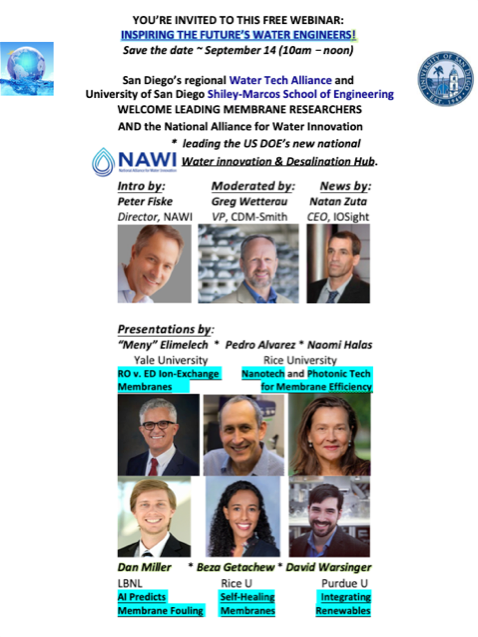
San Diego County and cities recycle treated wastewater for nonpotable use. Indirect potable reuse
has begun (2022) at Pure Water Oceanside, via aquifer recharge.
Pure Water
San Diego (City) and
East County Advanced Water Purification (San Diego County Water Authority) projects
will provide
50% of residents’ drinking water by 2035 with cleaned
wastewater to create
safe, drought-proof,
local potable water supplies, held in Miramar and San Vicente Reservoirs for municipal distribution.
These infrastructure projects require engineering of waste->water systems and construction of new
conveyances such as tunnels and pipelines, plus O&M water tech: pumps, valves, meters, etc.
Major engineering companies creating our water reuse infrastructure, spell WATER Supplies to us:
from WA Risic and WSP USA, AECOM and ARUP, to Tetra Tech, Evoqua, Richard Brady & Assoc.,
Richard Baker Int’l, and Shimmick as well as Stantec, the project management for Pure Water SD.
WATER, CHEMICALS, METALS & ENERGY
Wastewater holds valuable resources —in addition to water– to support other industries (agriculture, cement, electronics,…). Wastewater “mining” can recover chemicals (essential fertilizers nitrogen and phosphorus), and complex natural compounds (lignans in paper pulp enabling flexible concrete pouring with low water), as well as metals, and more. The #OneWater focus on wastewater for water reuse, has broadened to recovery of separated solids for reuse. Traditional (yet innovative —see Singapore’s ceramic) membrane bioreactor (MBR) processes used large effluent storage basins, where suspended solids gradually settled to <5 mg/l to meet Class B water reuse standards. Now, water resources recovery filtration (WRRF) innovators* use layered communities of an/aerobic microbes to biologically hasten the rate that biomass solids form into granules and rapidly settle into final clarifiers. Advanced biologically activated “mixed liquor sludge settling” (MLSS) effluent nutrient removal processes can avoid capitally intensive storage basins/tanks and pumps, and can reduce sewage treatment footprints by 75% and aeration mixer (pumped) energy by 50%. Packaged plug-and-play Moving Bed Biofilm Reactor (MBBR) units (easy to use by maintenance technicians and end-users), either for integration into the sewer network system to help reduce capital investments, or for standalone industrial onsite reuse, are exciting new market opportunities for giant water companies like Evoqua and Veolia.
@WaterTechAll_SD social media noted the 13th World Filtration Congress (WFC 13 in San Diego)
keynote by Evoqua CTO Dr. Jon McClean, on WTA Technology Advisory Board.
Biological wastewater treatment processes also release biogas, making biogas capture essential to San Diego’s Climate Action Plan goals. Energy can also be directly extracted from wastewater: sewage holds 5x the thermal energy needed to treat it (see Huber’s WinTherm system, a repeated winner at WEFTEC) and other wastewater energy tech noted by innovation experts (Isle Utilities).
Error: Contact form not found.
Error: Contact form not found.

Dawn Guendert’s career specialized in the planning and design of membrane systems for drinking water, potable and non-potable recycled water, and wastewater treatment applications. Her nearly 40 years of extensive experience included all aspects of the development of membrane treatment plants including feasibility studies, pilot studies, preliminary and final design, procurement and permitting.
Ms. Guendert’s career encompassed business development and product management for membrane technology providers; and roles as business development, project management and service group leader for national and international consulting engineering firms, namely Hazen and Sawyer, Carollo, MWH, and Veolia Water Technologies.
Her engagement with nonprofits includes serving on the Board of Directors of the Equinox Center from 2011 to 2014,and past volunteer for both Surfrider and Coastkeeper. Ms Guendert’s civic engagement includes serving on the City of San Diego’s Water Policy Task Force. Ms. Guendert currently serves as Co-Chair, Candidate Forums, for the League of Women Voters North County San Diego (LWVNCSD) and temporary Editor of the LWVNCSD Voter newsletter, as well as on the Board of the San Diego regional Water Tech Alliance.
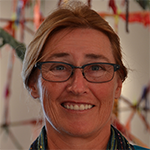
I am an experienced proposals writer specialized in scientific and technical research and team-building. With my M.S. in psychology and statistics (Tulane, 1983), I worked for Sociological Abstracts, then as Assistant Director/Director of Development for major community services agencies, followed by UCSD School of Medicine Development Dep’t roles (1994-2000), and medical writing as well as senior regulatory affairs roles at Ligand, CancerVax and Pfizer. Upon retiring from the biotech sector in 2015, I realized (thanks to BIOCOM, the biotech industry advocacy organization founded to ensure water security for its members) that droughts can undermine #SmartSanDiego successes. We are at the end of long drying pipelines from N. California and the Colorado River, both reduced by climate change, so regional resilience must be strengthened. We will solve our water challenges with reuse engineering and programmatic conservation incentives (I believe, as the daughter of an engineer and programmer). I co-founded the Water Tech Alliance in 2016 as a nonprofit (501c6) advocacy organization for the regional freshwater industry of 300+ companies, and to promote water tech innovations, initiatives, and collaborations —locally, nationally and globally— with municipal Pure Water potable reuse projects, with the US EPA Water Reuse Action Plan (sponsoring WRAP 4.5 onsite reuse of a/c condensate), and with the Water Technology Alliance of Denmark, as well as Israel, Mexico, and more countries holding brilliant keys to our water security in the challenging future ahead.

Cristina Ahmadpour is the President of Isle Inc. and Managing Director (Americas) of Isle Utilities, a leading global consultancy in the water sector (and an independent partner to over 80 water utilities in the USA and 400 globally, with a world-renowned Technology Assessment Group [TAG]). Isle brings economies-of-scale to solving shared challenges and interests that manage risk, save time and resources, and strategically drive value for organizations, communities, and collaborative partnerships. Cristina specializes in emerging technologies and innovative best practices, and leads a team that supports the most progressive water utilites to assess their needs, identify, evaluate, and engage best solutions, as well as accelerate innovation across the industry. The American Water Works Association contracted Cristina’s team to create the now highly successful “Innovation Lounge” for the AWWA’s Annual Conference and Expo (ACE2018-2022), featuring the most exciting new water technologies of the year. Cristina is a top speaker and moderator of water innovation-focused sessions at events such as the World Water Tech North America Summit, in 2021 discussing the role of the water sector in achieving carbon neutrality, and technological opportunities at the water-energy nexus. Repeatedly honored as a communicator (e.g, Donald G. Hileman Educator of the Year Award) for her abilities to “move the needle” toward innovation, Cristina points to her educational background: “I’m a proud graduate of Vermont Law School (summa cum laude) and the California State University system. I’m also honored to have been recognized by the Water and Wastewater Digest in 2016 and 2018 as a top water professional under the age of 40.”
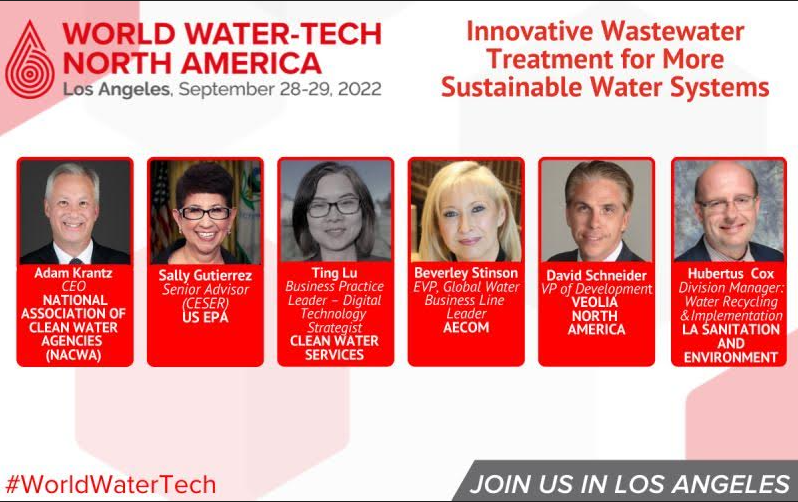
David Schneider is presenting on the panel ‘Innovative Wastewater Treatment for More Sustainable Water Systems’
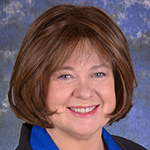
I am Vice Chair of the South Area San Diego County Democratic Party, the executive in charge of Democratic Party activities in the South Area of the County, an area roughly from the 94 to the border and the ocean to the mountains. In 2014, Democrats won 23 of 27 races by turning out Democratic voters, teaching them to vote all the way down the ballot and by presenting our message which is about our community engaging cross-over Republican voters. I’ve been responsible for oversight of field Campaign offices, fundraising, party and candidate strategies, communication and messaging.

Now speaking on the World Water-Tech North America conference panel
‘Innovative Wastewater Treatment for More Sustainable Water Systems”
David Schneider has more than 20 years of experience in the water and energy sectors, focused on project development; and he is determined to implement the environmental solutions necessary to secure water resources, address pollution and enact decarbonization to provides future generations a healthy planet. He is based in Southern California and his experiences includes developing small and large complex infrastructure projects including advanced water treatment processes and groundwater injection systems. As VP of Development and Marketing for Veolia North America (after they merged with SUEZ North America in 2020), he coordinates all technical, financial and legal components of municipal water and wastewater bids, and also oversees the projects. In 2020 with SUEZ he oversaw O&M for California wastewater projects such as the Burbank Water Reclamation Facility and the Edward C. Little Water Recycling Facility as well as three satellite facilities producing five different grades of recycled water including up to 15.4 MGD of advanced treated water for ground water injection. Prior to joining SUEZ, David served as Vice President of Business Development for Veolia, where he established a significant pipeline of business opportunities in both the water and energy sector, including the Hyperion Advanced Water Purification Facility to supply Los Angeles’ airport (LAX) with non-potable recycled water supporting the City of Los Angeles’ “One Water Plan”.
David also was the VP of Business Development for the Rialto Bioenergy Facilitym the largest organic waste digestion facility in California providing renewable energy and serving the Los Angeles are market for food waste diversion as required by California’s climate reduction policies. He takes a keen interest in green energy, particularly hydrogen.
Enhancing his professional experience, David holds his Master of Business Administration, as well as his Bachelor of Science degree in Chemical Engineering. He is also a member of the Water Environment Federation.
